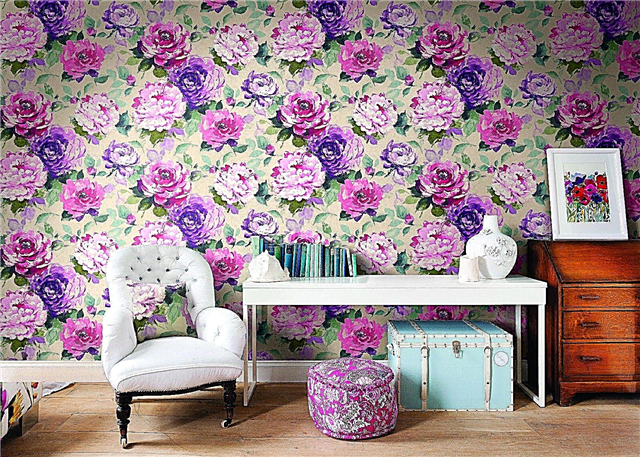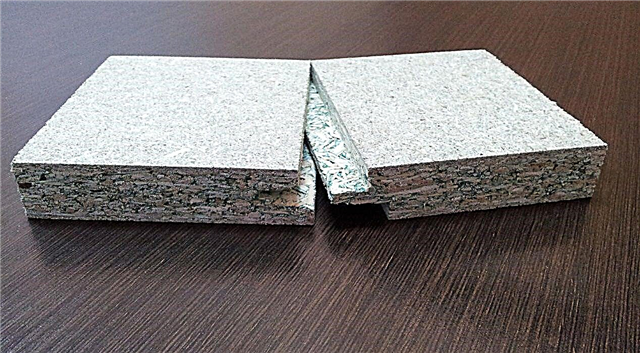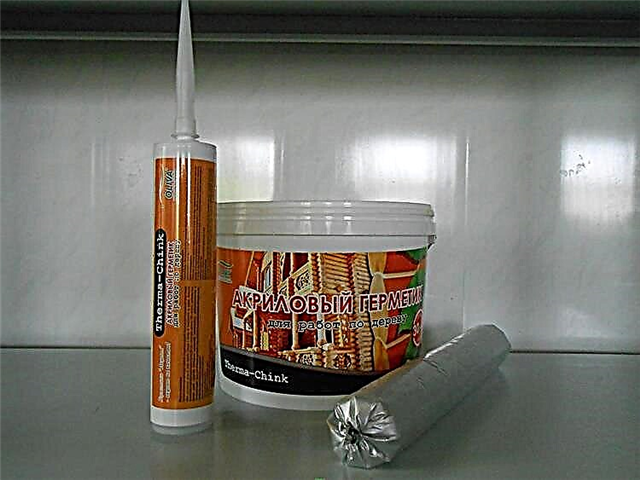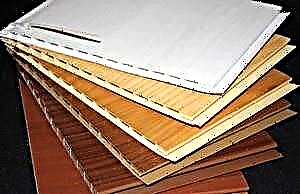 It's time to update the interior of the home. Wallpapering will take up the bulk of all cosmetic repairs. Glue is a bonding agent for wallpaper with walls. How to breed wallpaper glue? The answer to this question depends on several factors.
It's time to update the interior of the home. Wallpapering will take up the bulk of all cosmetic repairs. Glue is a bonding agent for wallpaper with walls. How to breed wallpaper glue? The answer to this question depends on several factors.
The composition of the glue and the method of its preparation may be one or another. In the modern world of building materials, there is a huge variety of types of soft wall cladding.
Each type of wallpaper corresponds to a specific adhesive composition. To learn how to spread glue for wallpaper, we will try to tell in this article.
Non-woven
The basis of the material consists of paper with the addition of fabric fibers. Wallpaper attracts consumers with its durability and high moisture resistance. If a "flood" occurs, the fallen pieces are dried and again glued to the wall. In this case, the painted surface retains its original appearance.
The peculiarity of the sticking is that glue for non-woven wallpaper is applied to the walls, and cut strips of wallpaper are smoothed directly on the surface.
What to add to water so that roses stand longer in a vase?
What people just do not come up with to prolong the life of beautiful flowers! There are such ways that you can’t even believe it.
And so we conducted an experiment - freshly cut roses were put in different versions of water with additives, peeped on the Internet. I do not pretend to the truth in the last resort, but we got a very interesting result))
So, we took: ordinary water, saline solution (2 tablespoons per liter of water), sugar solution (2 tablespoons per liter of water), a weak potassium permanganate solution, a glass of vodka, water with 5 tablets of aspirin, we also bought a special solution in the store ( I will not call, so as not to advertise the manufacturer), a sprite (yeah, and this is also on the Internet as a means of extending the life of flowers), and finally, a solution of citric acid (a teaspoon per liter of water). Every day I won’t describe our experiment, I’ll just say that the first “rose” rose in saline, then the rose in aspirin, then they threw the rose out of plain water, then there were potassium permanganate, special equipment, sugar and vodka, citric acid and sprite became the leaders, (although the leaves were slightly yellowed from the sprite). On the seventh day, our experiment was completed. won the sprite)
7 4 · Good Answer
What is wallpaper or stretch ceiling glued first?
Hello! Any stretch ceiling can be mounted on top of an existing finish in a room where the repair is fully completed and the furniture is standing. On the site we have detailed information about this. Even if you have cabinets, a built-in headset, air conditioning, there will be no problems with this.
But if your repair is just beginning, we advise you to think about a more convenient sequence of work. The specialists of Ceilings Smith, based on their experience, recommend first a ceiling, then a wallpaper. When drilling walls to fix the baguette, although a perforator with a vacuum cleaner is used, dust is formed, which settles on the wallpaper, especially on the textured. I don’t really want to remove it from there later.
On average, wallpapers change every 5-10 years, and stretch ceilings do not lose their appearance after 30 years. And to re-stick the wallpaper, if they were installed before the stretch ceiling will not be very convenient. Have to pull them out from under the profile. If the wallpaper was glued after, then replacing them will not require so much effort. This is especially true for children's rooms and kitchens, where you most often have to do this.
For large rooms, there is an installation without drilling walls using an assembly gun. Dust is not formed. So, the choice is always yours, and we only offer the best option.
Metal
The metallized surface of this type of coating imitates the structure of various metals and alloys interspersed in the overall color of the walls.
The addition of thin aluminum foil gives the wallpapers a beautiful, austere look. Wallpaper is easy to clean.
Liquid
The technology of applying liquid coatings has nothing to do with wallpapering. Use of glue is excluded.
| № | Type of wallpaper | Advantages | disadvantages | Glue type |
|---|---|---|---|---|
| 1 | Paper | Low price, environmental friendliness | Do not wash, burn out | Any wallpaper glue |
| 2 | Non-woven | High strength | When wet, do not lose their properties | Adhesive only for non-woven and vinyl |
| 3 | Vinyl | Moisture resistant, re-dyeable | Air tightness | Adhesive only for non-woven and vinyl |
| 4 | Acrylic | Let in air | Less durable than vinyl | Adhesive only for non-woven and vinyl |
| 5 | Textile | High esthetics | Accumulate dust | Any increased density |
| 6 | Metal | Bright appearance | Expensive | Any increased density |
| 7 | Natural | Natural appearance | High price | Any increased density |
| 8 | Cullet | Durability | Monotonous colors | Special glue for glass |
Wallpaper glue breeding technique
The adhesive composition is prepared in the usual traditional way:
- First of all, you need to prepare a clean dish where you will spread wallpaper glue. Prepare a tool for stirring the adhesive solution: brushes, a wooden spatula or a mixer nozzle on a drill.
- After reading the instructions on the back of the package with glue, determine the amount of water for preparing the mixture.
- Half of the required amount of water is poured into clean dishes.
- By thoroughly mixing the water, the powder is gradually poured into the container. They do not immediately pour out all the dry glue, but half of it.
- As a thick consistency of the mixture is formed, the remaining water is gradually poured and the remaining adhesive powder is added.
- As a result of mixing, a mass without lumps should form. The mixture is left alone for 10 to 15 minutes. Then mix the resulting solution again. See the full instructions in this video:
It is necessary to study the instructions on the packaging of each type of glue. The proportions of water and dry glue, as well as the time of mixing, are the data obtained on the basis of laboratory tests by the manufacturer. In order to avoid the occurrence of any flaws in the pasting, it is necessary to strictly comply with the requirements of the instruction.
Types of Wallpaper
One of the most common and well-known - paper. They are popular because of the low prices and ease of handling. Single-layer - with a smooth surface, two-layer with a relief. Non-woven fabrics consist of paper backing and fabric fibers. Buyers have long appreciated their main qualities: strength and good resistance to moisture.


The situation when you are flooded with neighbors from above is familiar to many. And if ordinary wallpaper from water deteriorates irrevocably, then with non-woven everything is different. They can be dried and re-glued to the wall. They will look like new.


Vinyl wallpaper is characterized by deep relief patterns. Acrylics are called "breathable." Outwardly from vinyl they do not differ. In addition, there are also textile, metallized, glass. AND for each type a specific glue is used, which, of course, facilitates repair work. After you have decided what kind of wallpaper will decorate your rooms, you can think about glue. Usually it is sold in the same department, and the seller will definitely tell you which one is better to choose.


How to choose the right glue?
Three types of glue are distinguished. For light wallpapers with a paper base, and he is not able to cope with other types.
The composition for heavy (vinyl and natural) includes PVA glue. There is a universal one, it is designed for all types of decorative coatings, including non-woven wallpaper. Here the most important thing, focusing on the instructions, to properly prepare the glue. Especially popular in this case is "Metylan". It is especially convenient if the glue contains a so-called indicator. Due to the pink tint, it is possible to evenly apply the composition to the paper web without missing a single section, which is very important when wallpapering on the wall. After drying, the dye does not leave any stains.


For conventional paper coatings, traditional wallpaper glue is perfect "Moment". There are varieties of it for vinyl and non-woven wallpapers. It is called Extra Moment, “Moment non-woven”, “Moment vinyl”. Many modern adhesives include bactericide and fungicide. If you do not want to repeat the repair in the near future, it is better to choose a composition with such components. In this case, you will insure yourself against the appearance of mold, fungus and blood-sucking insects.


How to calculate?
If you do not want to be distracted from repairs and interrupt a fascinating lesson in the most interesting place, think in advance - how much glue you will need. Notice if your walls are even. If their quality is poor, apply a primer. Perhaps the first time you are not satisfied with the result. And the procedure will have to be repeated twice.


Consider what type of wallpaper you use. If it’s heavy, then more glue will be spent on it, since it needs to be thickened. Wallpaper in this case will hold well and after drying will not peel off at the joints. Some people correct their mistakes the next day using superglue. Do not allow this. When peeling off joints, use a special pencil. Thanks to the thin shaft, it is convenient to use. After him no trace remains. And the wallpaper pattern won't get hurt

Useful Tips
Prepare everything you may need in advance:
- a clean container, preferably about 10 liters,
- water at room temperature
- stirring spatula, measuring spoon,
- drill, mixer.

- We proceed to the preparation of glue and observe the proportions indicated on the package.
- Stirring the water with a stick, pour the right amount of powder into a thin stream. Then we connect a drill or an ordinary mixer and achieve an even consistency, without a single lump.
- Always breed only one half of the box. Then, if necessary, the second. It is better to add glue in the first half hour, then it will swell, it will be difficult to mix it evenly, and there will be clots in the water that you don't need.


- There is a little trick when breeding glue. Use only one nozzle from the mixer. With its help, the mixture is evenly mixed and nothing will scatter around the container.
- When the glue is completely ready, leave it for 15-20 minutes, so that it swells well.


How much to store?
Situations are different. You prepared all the rules of glue, and the repair had to be postponed. Or there is an excess solution, and before gluing the wallpaper in the next room is still far away. There is no single answer to the question of how much to keep diluted glue. It all depends on its quality and other factors. But you can insure yourself against the use of a low-quality product.

Pack the remaining glue on top with plastic wrap or close with a tight lid. In this form, it can be stored from two to five days. After this period, see for yourself: does the glue have an unpleasant smell, has the consistency changed. If these symptoms are present, discard the adhesive. If it looks pretty decent, try sticking a small piece of wallpaper on any part of the wall and check how it holds. If everything is normal after drying, proceed to a large volume.

There are also ready-made types of glue sold in a liquid state. It is convenient in that it does not need to be bred; in its manufacture, ideal proportions are observed. And manufacturers guarantee that it can be stored for at least a year and does not lose its properties and quality.

Cooking paste
Despite the abundance of various types of glue, some prefer to prepare the mixture at home, believing that there is nothing more reliable. The paste is made from ordinary flour (150 grams per 1 liter of water). Pour flour into a clean container, add water, mix thoroughly until a homogeneous consistency. Then simmer for 7-10 minutes. If lumps still remain after cooling, filter the glue through a sieve.
It should be noted that paste only suitable for plain paper wallpapers. They do not need to glue non-woven. The next day, the sheets move away from the wall and re-stick them will be problematic. The paste will disrupt the structure of the wallpaper and special glue will not take it.
Do not save or create unnecessary problems for yourself. After all, you do repairs not for one day, but for at least a year, or even more.

See how to make a paste in the next video.
Popular wallpapers
Now many prefer to choose non-woven. With a variety of colors and patterns, they are of high quality. And if you choose the right glue and dilute it in accordance with the instructions, these wallpapers will last a long time.

If you have uneven walls, with cracks, roughness, this type of coating will easily hide it. No additional surface treatment required. It is enough to apply glue to the walls, and then immediately glue the wallpaper.
In a word, you decide and choose. Do it right and have a good repair!
Conclusions on the topic
In this article, we introduced you to the seemingly obvious topic of how to properly spread wallpaper glue. If you still doubt how to properly spread the glue in your case, then just write to us in the comments and we will try to answer your question. In short, it’s better to slightly dilute the glue with water than pour a lot of water and get a weak consistency.
Also remember that the glue is best mixed with the aid of a special nozzle on a drill than by hand. So you get a better composition without lumps.
Wallpaper glue consumption
Most companies put information on the approximate consumption of the adhesive on the packaging of their products, however, such data does not correspond to reality. The fact is that each application of the material is unique. Certain conditions can significantly increase or decrease the quantitative consumption of the adhesive mass, so some inconsistencies with the consumption stated in the instructions are possible.
The type of wallpaper is an essential point requiring special attention before starting the dilution of the material with warm water. The denser the structure and weight of the wallpaper, the glue mass should be thicker.
A little trick! In this situation, it is possible to reduce the working consumption of the fixing substance provided that the wall surface is properly prepared. Approximately reduce consumption by a third as follows:
- the use of a two-layer primer instead of a single application,
- the use of all materials from one manufacturer!
The structure of the main surface is the features of the material on which the wallpaper is glued (concrete, wood, drywall, etc.). In some cases, this seriously affects the flow rate of the adhesive mass. For example, rough and porous surfaces require a greater volume of fixative, in contrast to dense and smooth analogues.
Let us analyze the most probable consumption of glue (with reference to vinyl wallpaper):
1. When the surface needs to be pre-primed, the mixture (in dry form) is diluted with heated water in a ratio of 1:40. This proportion is obtained by dissolving a standard pack (300.0 g) of the substance in a container with 12.0 liters of water. The resulting amount of glue is enough for a full primer of approximately 100.0 square meters. m. concrete-brick walls.
2. For the gluing of structural, textile or vinyl wallpaper, a rather thick adhesive mass is required.The dry powder of the fixative (300.0 g) must be carefully diluted with heated water (6.0 l) - a proportion of 1:20. The prepared amount of the mixture will be sufficient for thorough processing of approximately 36.5-40.3 square meters. m
3. Thin, light wallpaper can be glued with not so densely saturated glue. You can dilute a 300.0-gram package with 9.0 liters of water in a proportion of 1:30. The resulting volume, with proper application, will cover 45.5-50.3 square meters. m. working surface.
The principles of using wallpaper glue
In essence, the process of wallpapering consists of a number of successive stages:
- preparation of the adhesive mixture,
- pasting the walls with wallpaper material.
Let us consider in more detail the subtleties of these necessary stages.

Cooking the main surface
First and foremost, the wall surface must be carefully prepared. The designated work front consists of a set of actions.
1. Cleaning (removal) of the old coating to a solid foundation (plaster, brick, concrete, etc.). The wallpapers to be removed must be carefully soaked with clean water and scraped off with a spatula. The tile is usually knocked down and the paint is removed with a suitable active solvent.
2. Leveling the surface - thoroughly repair cracks, crevices and other defects with paste-like plaster, and the protruding parts are removed with a hammer or compact chipper. After the done manipulations, rough polishing is carried out with sandpaper. Then the surface is cleaned of all contaminants, smoothed out with putty and re-cleaned with a sandpaper, but of a finely abrasive type (P140 – P170).
3. Primer walls - this is a mandatory procedure necessary to strengthen the base structure, increase adhesion to glue, reduce its consumption and so on. For this purpose, it is strongly recommended to use glue, which will subsequently fix wallpaper sheets to the surface.
4. Adequate drying of the applied primer. As a rule, this takes about four hours.

How to breed wallpaper glue?
Bring glue for wallpaper with purified water, following the instructions in the instructions attached to the substance.
The sequence of actions is most often as follows:
- the required volume of water is poured into a deep container (plastic or enameled),
Attention! If you use cold water, the time of stirring and cooking the glue will double. When heated water is taken for dissolution, the powder concentrate dissolves almost instantly, but there is a risk of lumps-clots. In the latter case, constant monitoring and continuous stirring of the mixture until complete cooking is required!
- falling asleep dehydrated (dehydrated) glue granules in small portions in a container with water. The solution must be thoroughly mixed.
 It is most convenient to carry out high-quality mixing with a construction mixer or a drill with a mixer nozzle at a slow high-speed mode. When there are no similar tools, the prepared mass can easily be stirred with a suitable stick or, for example, a plastic tube,
It is most convenient to carry out high-quality mixing with a construction mixer or a drill with a mixer nozzle at a slow high-speed mode. When there are no similar tools, the prepared mass can easily be stirred with a suitable stick or, for example, a plastic tube,
Advice! It is very convenient to cook the adhesive mass together with an assistant - someone pours granular powder, and the second - constantly mixes the composition!
- keeping the glue for 14-17 minutes, until the homogenization of the thick solution is completed,
- final mixing of the mass, after which it will be completely ready for the start of finishing work.
Wall pasting with selected wallpaper
After preparing the wall surfaces and diluting the adhesive, you can begin to glue the wallpaper. The whole process of such decoration is simple and basically consists of:
- precise cutting of the material,
- accurate application of glue,
- transfer and gluing of coated sheets with fixative on the walls.
 However, there are a number of nuances, the implementation of which is necessary for the high-quality performance of a beautiful finish.
However, there are a number of nuances, the implementation of which is necessary for the high-quality performance of a beautiful finish.
1. If paper (thin) wallpapers are used, then only the wall surface should be covered with adhesive solution. This type of wallpaper cannot be wetted during gluing, otherwise the sheets will burst and burst during manipulations. In other cases, varieties of wallpaper are also subject to a layer of glue.
2. It is more efficient and more convenient to spread the adhesive with a paint roller or flat wide brush. During application, it is important to work out each section of the wallpaper strip so that there are no dry areas.
Explanation! Most modern adhesives become pink or blue after dissolving. This helps to visually control the quality factor of processing the back of the sheet strips. Color after drying completely disappears!
 3. After applying the adhesive on the wall and on the surface of the wallpaper, you should wait for the right time (approximately 6 minutes) for its full distribution.
3. After applying the adhesive on the wall and on the surface of the wallpaper, you should wait for the right time (approximately 6 minutes) for its full distribution.
4. The time for full drying of the glued wallpaper directly depends on the type of material:
- paper - 10-12 hours,
- vinyl and non-woven - 22-25 hours,
- cullets and coatings for painting - at least 32 hours.
5. You can’t speed up the drying process (fans, opening windows, etc.) in any way; otherwise, the decorative material will move away from the surface, deform in some places, or “bubble”.




